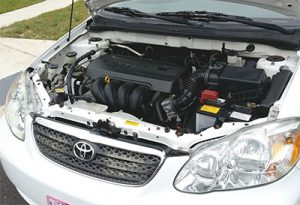Does your manufacturer recommend that your vehicle goes 5- 7,000 miles or more between oil changes? In our last post, we discussed the importance of using the correct oil and filter. In this post we address this reality:
Longer oil change mileage intervals mean fewer visits to the shop and fewer opportunities to have your whole vehicle inspected.
And why could this be a problem?
 Because it could result in important preventive maintenance services for your vehicle being missed or postponed. Solution: Why not stop by your local auto service provider every 5,000 to 6,000 miles and have them check your vital fluid levels and give your vehicle a once-over?
Because it could result in important preventive maintenance services for your vehicle being missed or postponed. Solution: Why not stop by your local auto service provider every 5,000 to 6,000 miles and have them check your vital fluid levels and give your vehicle a once-over?
Here are five things that shouldn’t be missed when taking your vehicle in for preventive maintenance between extended oil changes…
1. A Lot Rides on Your Tires
Aim to have your tires rotated every six months or 6,000 miles, or whichever comes first. Frequent rotation ensures that wear is distributed evenly. Extreme temperatures can cause tires to under-inflate, resulting in poor gas mileage and potential safety hazards. It’s also wise to take a look at them each month to make sure they’re properly inflated.1
2. Your Engine Needs to Breath: Air Filters
A good air filter, which stops harmful dust and particulate, will also add longevity to your vehicle’s engine. Have your air filters replaced every year or 12,000 miles2, or when recommended by a trusted automotive repair facility.
3. Stop It: Brakes Inspected
Don’t wait until you hear your brakes squeaking to get them checked; have them inspected every six months3 or when you have your tires rotated.
4. Think safety: Lights On?
Don’t neglect your lights, as they are another important safety feature for visibility on the road. Instrument panel lights should illuminate on your vehicle’s dashboard when the ignition is turned, but before the engine starts. If a warning indicator comes on while driving, it’s time to pay a visit to your auto professional.
5. Start Something: Battery Check
A faulty jumpstart in modern, advanced cars can damage sophisticated computer systems. If you’re stuck with a dead battery and you’re not confident how to perform a proper jumpstart, call for roadside assistance. Remember, a car battery has an average lifespan of 3-5 years. Insist on having the battery tested by your auto technician every time you come in for service, and you’ll reduce the risk of being stranded with a dead battery.
The Takeaway
Longer oil change service intervals on today’s vehicles make it vital to have your entire vehicle thoroughly inspected during each and every preventive maintenance service. As a result, important services won’t be missed, and your vehicle will perform efficiently and safely for many, many miles.
At Mighty Auto Parts, we partner with over 12,000 auto repair centers, supplying them with high-quality auto parts. We pride ourselves on working with dependable service providers, so you always drive home happy.
To learn more about our products and services, visit us online at mightyautoparts.com, or find your local Mighty Representative today.
1 Source: Grand Prix Driving School
2 Source: Grand Prix Driving School
3 Source: Grand Prix Driving School
What an eye-opening and informative blog post! Your detailed breakdown of extended oil change intervals is incredibly valuable for anyone looking to maximize their vehicle’s efficiency and longevity. Your emphasis on the potential downsides and the importance of striking a balance between extended intervals and regular maintenance is spot-on. It’s clear that you’ve done your research thoroughly and are dedicated to providing readers with accurate and well-rounded insights. Your commitment to helping your audience make informed decisions about their vehicles is truly commendable. Thank you for shedding light on this crucial aspect of car care and for encouraging responsible maintenance practices. Your blog is a must-read for anyone who wants to take the best possible care of their vehicle!
Thank you, Dever!